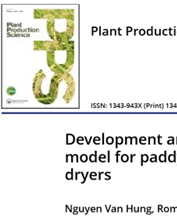Nguyen Van Hung (a), Romualdo Martinez (b), Tran Van Tuan (c) and Martin Gummert (a) (a) Sustainable Impact Platform, International Rice Research Institute (IRRI), Los Baños, Luzon, Philippines; (b) Bioprocess Engineering Division, Philippine Center for Postharvest Development and Mechanization, Munoz, Nueva Ecija, Philippines; (c) Center for Agricultural Energy and Machinery, Nong Lam University, Ho Chi Minh City, Vietnam
---------------------------------------------------------------------------------------------------------------
Nguyen Van Hung (a), Romualdo Martinez (b), Tran Van Tuan (c) and Martin Gummert (a)
(a) Sustainable Impact Platform, International Rice Research Institute (IRRI), Los Baños, Luzon, Philippines;
(b) Bioprocess Engineering Division, Philippine Center for Postharvest Development and Mechanization, Munoz, Nueva Ecija, Philippines;
(c) Center for Agricultural Energy and Machinery, Nong Lam University, Ho Chi Minh City, Vietnam
--------------------------------------------------------------------------------------------------------------
Journal Plant Production Science
ISSN: 1343-943X (Print) 1349-1008 (Online) Journal homepage: http://www.tandfonline.com/loi/tpps20
ARTICLE HISTORY
Received 15 June 2018
Revised 11 August 2018
Accepted 28 August 2018
----------------------------------------------------------------------------------------------------------------
ABSTRACT: This research developed a computer-based simulation model applicable for conventional and reversible airflow flatbed dryers, which can be used to predict the optimized time for mixing paddy (for the conventional flatbed dryer) and reversing the drying air (for the reversible air flatbed dryer). The developed software has the ability of simulating the paddy moisture content and temperature based on the input parameters of ambient (temperature and relative humidity) and drying air (temperature and airflow rate), dimensions of the dryers, and input grain proper- ties and weight. The model was verified based on data collected from actual paddy drying practices in Vietnam from 1994 to 2015. Relative errors between modeled and measured moisture content of paddy varied for different stages of the drying process and different dryer capacities. On average, the error was highest at the middle stage of the drying processes. This error increased gradually during the early two-thirds stage of the drying process and reached 19% and 14% for the conventional and reversible air flatbed dryers, respectively. On the other hand, these errors decreased to less than 10% at the end of the drying process. Accurate prediction of optimized machine operating time determines the uniformity of the final moisture content of paddy between top and bottom layers, improving energy efficiency, and reducing postharvest losses and drying cost.
Số lần xem trang: 3721


